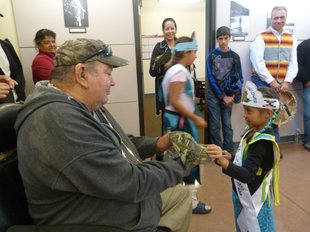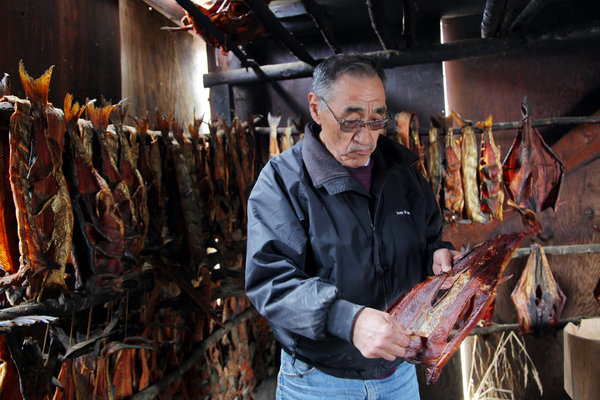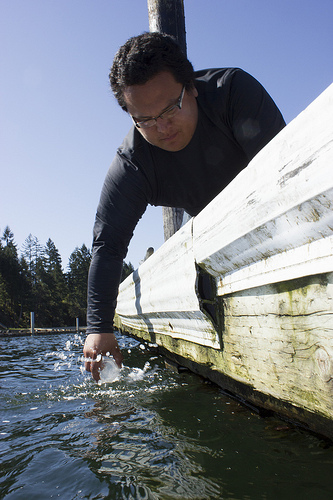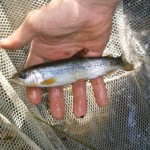
BRIDGEPORT — Hundreds came Thursday to celebrate the new, $50 million hatchery, its concrete raceways, its incubation building, its state-of-the-art plans to raise and release 2.9 million chinook salmon while protecting their wild cousins.
The Confederated Tribes of the Colville Reservation officially opened the Chief Joseph Hatchery bordering the southwest corner of their reservation.
Funded by ratepayers through the Bonneville Power Administration along with Grant, Douglas and Chelan County PUDs, the new facility is expected to bring thousands more spring and summer chinook back to the upper Columbia River for both tribal and non-tribal fishermen.
Those who gathered for opening ceremonies spoke largely about the history of events that led to this day, hailed as the fulfillment of a promise made by the U.S. government before the Great Depression.
First, a traditional salmon song and then tribal members caught the hatchery’s first salmon using a pole net.
Whooping cries and large smiles erupted as the salmon was laid on the aluminum platform, then filleted at a table nearby, its eggs and innards tossed back to the Columbia below.
After the riverside ceremony, tribal fishermen were honored, many speaking of times when the fish were abundant, and shared by all.
It was this place where Colville tribal fishermen came to fish after the construction of Grand Coulee Dam, and later Chief Joseph Dam — just across the river. The dams erased Kettle Falls, one of the largest fishing spots on the Columbia River, where tribes from around the region gathered yearly.
With no fish passage, the dams were barriers to spawning salmon, which still return each year to the concrete wall that prevents them from completing their journey.
So fishermen came here to fish from the rocks, and the bridge, or the wall below the dam.
World photo/K.C. Mehaffey
Freshly caught salmon was cooked and dried using traditional methods at opening ceremonies for the Chief Joseph Hatchery on Thursday. Hundreds of people came to celebrate the new facility, which will produce nearly 3 million smolts for release.
“If you needed something, we all shared,” said Lionel Orr, who had offered up the morning’s salmon song. “It was like a community. If I had fishing line, or hooks, I’d give it to you. It was really a good experience.”
Mel “Bugs Hook ‘Em In The Lips” Toulou recalled being accepted into the clan after catching his first salmon on a ten-foot bamboo pole. “What you feel down here is the brotherhood, and the family that you gain,” he said. They used to catch 50 and 60 pound fish, he said, and their fathers and grandfathers reeled in 100-pounders. Today, the salmon average 25 pounds he said.
Ernie Williams recalled catching 750 pounds of salmon in 72 hours once. And then giving it away to elders on their way home. He praised the rain as “soul cleansing,” and said his mother, Mary Marchand, and other elders who had passed on were there with them. “Those past fishermen too. I know they’re all here, and they’re smiling, too.”
Officials, too, spoke of the past.
John Smith, the first director of the Colville Tribe’s Fish and Wildlife Department, talked about the collaborative effort it took to build the hatchery, with not only the tribes, but state and federal agencies, PUDs and the support of other tribes.
He said he hopes people aren’t upset when they see tribal members catching these new hatchery salmon from boats or scaffolds, using nets or spears.
“What you’ve got to remember is, we’ve been denied a lot of good fisheries for a lot of years,” he said. “I’ve seen the devastation that’s been caused,” he said.
Fish were once 50 percent of their diet, and the dams cut off that food source for so many, he said. “That was like cutting you off from Safeway or Walmart. That’s what it did to our people.”
Federal officials also spoke of the impact that these dams without fish passage had on tribal people, and the promises made to for another hatchery.
Tom Karier, a member of the Northwest Power and Conservation Council, said an old document of an 1800s missionary near Kettle Falls revealed that it was not uncommon for tribal fishermen to catch 1,000 fish a day, or count hundreds of salmon jumping out of the water on their way upstream.
“We have come a long way, but we still have a long way to go,” he said. “Today, we celebrate significant progress.”
World photo/K.C. Mehaffey
Sneena Brooks, Robbie Stafford and Dan Edwards were among the drummers singing an honor song for elder tribal fishermen at the opening of the Chief Joseph Hatchery on Thursday.
Leroy Williams, a tribal fisherman who is teaching others the old ways of fishing with hoop nets and dip nets, recalled discovering the letter from the U.S. Bureau of Reclamation for a fourth hatchery while sorting through papers for the tribe’s fish and wildlife department. The Great Depression and World War II delayed the project, and he promise had been forgotten until they rediscovered this letter.
Hatcheries had been built at Leavenworth, Entiat and Winthrop, but this one was delayed by the Great Depression and World War II, and then forgotten.
The new hatchery is located on 15 acres owned by the U.S. Army Corps of Engineers on the north bank of the Columbia River, just downstream of Chief Joseph Dam. The complex includes 40 raceways, three rearing ponds, and three acclimation ponds. It draws water from wells and the reservoir behind the dam, known as Rufus Woods Lake.
Colville Tribal Chairman John Sirois expressed gratitude for all the support from tribal members and former council members, agencies, and other tribes.
“This is truly humbling, and a day that we’ll remember forever,” he said.
Related: New Chief Joseph Salmon Hatchery: Restoring the Runs, Restoring the Culture
Elsewhere on the Columbia River, the Nez Perce, Umatilla, Warm Springs, and Yakama tribes began commercial sales from their summer fishery on June 17, the Columbia River Inter-Tribal Fish Commission announced.
“This is the first significant commercial fishery of 2013,” the commission said in a media release. “Pre-season forecasts estimate 73,500 summer chinook and 180,500 sockeye. Depending on the actual run sizes, Indian fishers may harvest approximately 20,000 summer chinook and 12,000 sockeye, most of which will be sold commercially.”
Read more at https://indiancountrytodaymedianetwork.com/2013/06/20/chief-joseph-hatchery-opens-salmon-ceremony-150029











